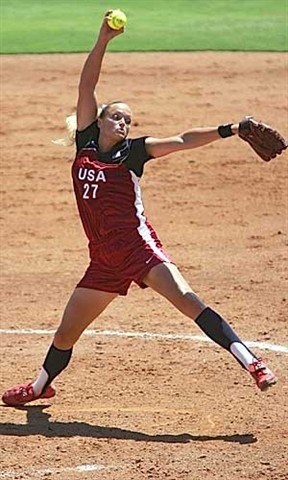There are a lot of baseball fans who have only a passing familiarity with women’s softball, which is too bad. College softball is a fast-pitched, fast-paced game where every play seems to be a “bang-bang” play—meaning there’s no such thing as a slow routine groundout or a leisurely walk home by a runner on third on a sacrifice fly. It’s an exciting brand of ball.
Of course, softball is a different game from baseball, played on a field with shorter dimensions, a shorter distance from pitcher to catcher, and a bigger ball. Also, the top collegiate female softball pitchers can—and often do—dominate the game. But few baseball fans know the names of some of the top pitchers, such as Jennie Finch and Danielle Lawrie. In her senior year at the University of Washington in 2010, Lawrie threw three perfect games and a no-hitter.
Throw me the heater.
A “baseball fan,” in general, follows Major League Baseball, the league where pitchers for decades have brought the heat with a hardball thrown from an elevated mound to a batter primed to hit it over the centerfield wall 400 feet away. Even with pitchers like Roger Clemens, Madison Bumgarner, Bob Gibson or Sandy Koufax on the mound, there have always been players like Mike Piazza, Willie Mays, Miguel Cabrera, Willie Stargell or Albert Pujols who could potentially hit one out at any time.
Certainly, if these heavy hitters could hit the best “flamethrowers” in the Majors, they’d be able to handle anything a female softball pitcher could bring to the plate…right?
What’s your guess? I mean, could you imagine Piazza or Pujols facing a softball pitcher? Stand back, everybody….
Jennie Finch vs. the best.
It’s surprising just to see and learn what happened when Jennie Finch took the mound against the top MLB hitters about 10 years ago. She was a collegiate champion (University of Arizona) and an Olympic champion (2004 and 2008). In 2004, she took part in the Pepsi All-Star Softball Game, along with a number of MLB players. She was there primarily as a guest coach.
She had faced a few hitters during the pregame fun and Albert Pujols was one of them. (Keep in mind that’s a 2004 version of Albert Pujols.) The players on both sides, mostly Major Leaguers, were anxious to see what happened when Finch faced Pujols. Let’s set the stage a bit:
So how did Pujols do?
Pujols said afterward, “I never want to experience that again.”
Game situation.
That was just pregame fun. In a game situation, perhaps the results would be different¬—by then one of the other hitters, after talking to Pujols, would know how to get the bat on the ball. Here’s what happened when Jennie took the mound during the game with her team leading 9–1.
“I never touched a pitch,” Giles admitted. “Her fastball was the fastest thing I’ve ever seen from that distance. It rises and cuts at the same time.”
What does that say about the Major Leaguers? And what does that say about those players at the collegiate level who managed to get hits off Jennie Finch? Mike Cameron, an outfielder for the Mariners, faced Jennie later that year but couldn’t touch her fastball. He wondered out loud, “Girls hit this stuff?”
The secret of her success.
If players like Pujols, Piazza and Giles can hit 95-mph fastballs, why couldn’t they hit Jennie Finch’s 68-mph softball? Finch gave a possible explanation to ESPN: “With the closer distance from the mound, I think it really surprises them how fast the pitch gets there. And especially with the rise¬—when they’re used to that over-the-top release point, there is nothing else like it. The ball movement throws them off.”
All true. But there’s something missing there, something a bit more scientific and research- based that helps explain it all:
1.A Major League hitter on a baseball diamond has more “time” to see the ball, even though that view is for milliseconds. Once the ball has traveled about 10 feet, a hitter can assess where the ball is going, how fast it’s coming and then start his swing—even if it’s a 90-mph fastball, it’s still 45 feet away. That “window” of opportunity is all a hitter like Pujols needs to put a home-run swing into motion. Remember, these are the best of the best.
2.However, against a pitcher like Jennie Finch, that window just isn’t the same. By the time the batter “sees” the pitch, it’s too late to pull everything into place—the ball is too close by that time (maybe 25 feet) and coming in like a 90-mph fastball. It’s hard to get the fat part of the bat on the center of the softball.
3.Also, a baseball takes a downward trajectory from a pitcher on the mound, so a hitter can swing down to connect. As Jennie Finch said, Major Leaguers don’t face an underhand pitch with upward trajectory.
So does that mean there’s no chance for a Major Leaguer to hit a top-notch softball pitcher? Not at all. Research has shown that premier hitters learn to use other clues and cues (a pitcher’s movements, arm position, etc.) to help them determine where a pitch is coming from and when to swing.
In other words, you might ambush big league hitters on a softball diamond with a surprise appearance by a supreme softball flamethrower…but a top-notch baseball player who got to see that kind of pitching regularly would likely make adjustments and start to make contact.

